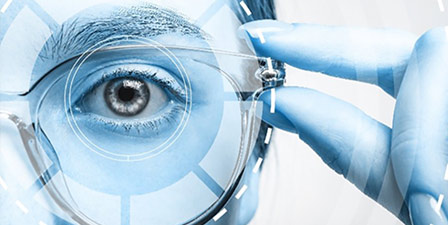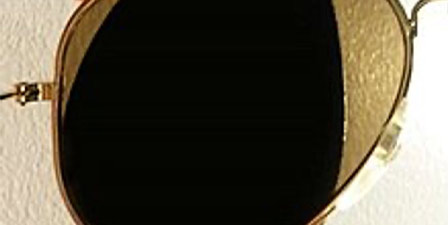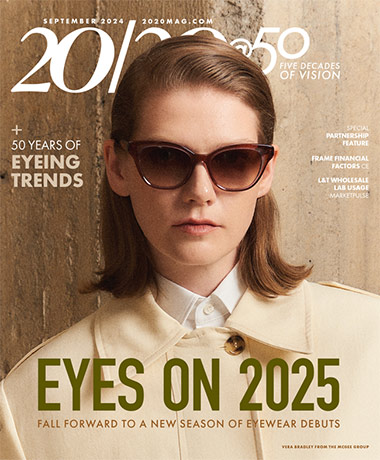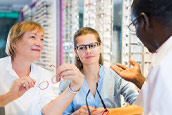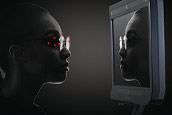Helping others see better is our ‘stock in trade’ as Opticians. Reducing blur caused by blue light, indoors and outdoors, improves acuity and reduces eye strain and fatigue. Consumer studies tell us that we want products that help us live better. There is little more important than comfortable vision both indoors and out.
Blue Blur – Blue wavelengths of light scatter more in our environment and in our eye, leading to glare which reduces contrast sensitivity, degrades image quality, and contributes to eye strain.
Due to its higher index of refraction blue light also results in ‘Blue Myopia’, the defocus of blue light on the retina.

When light waves scatter off of small particles (less than one tenth of the wavelength), some become polarized, in particular, any light scattering at an angle of 90 degrees away from the lights original direction of travel. The small molecules that interact with the electromagnetic field of the blue photons of light to produce scatter are prevalent in our atmosphere, the air, and the ocular media (transparent structures) of our eyes.
Our blue sky is attributed to blue wavelength scatter in our atmosphere.
Blue eyes are attributed to blue backscatter that reflects blue wavelengths back out of the eye, in an iris that lacks melanin. The irises are not actually blue but instead are reflecting blue wavelengths. When melanin is present, it absorbs blue wavelengths making the iris appear brown.
Glare. Blue light scatter results in veil luminance, which is referred to as blue haze preventing clear, crisp vision. Green and red wavelengths are longer wavelengths with lower frequencies that travel further without being absorbed and scattered, allowing us to see them clearly. Hence their use in traffic signals.
Contrast sensitivity refers to our sensitivity to the relative difference in luminance of a target from its background.
Scattered blue light increases the luminance or brightness of the target and the background to equal amounts reducing contrast, which results in disability glare. In other words you cannot distinguish the target from the background, detail is lost, and edges are ill-defined. http://sdhawan.com/ophthalmology/glare.html
Intraocular Blue de-focus and scatter

Intraocular Light Scatter
Normal Eyes
Cornea 30%
Lens 70%
Aqueous & vitreous < 1%
Disabling glare is the result of the scattering of light in the ocular media of the eye, which temporarily obscures vision (blinding). The sun during the day or headlights at night are two sources of disabling glare.
Although we are all impacted by glare from blue light scatter, let’s consider those who suffer from conditions that increase light scatter. People with low levels of blue absorbing macular pigment known as MPOD (the elderly lose a substantial amount of their MPOD impeding their natural defense against intraocular scatter), light colored irises, lens opacities (cataracts) and corneal opacities, aphakic/pseudophakic and Lasik patients all suffer from increased intraocular blue light scatter.
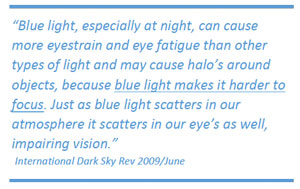
Sources of Blue Light
Indoors
Screens: TV, computer, smartphones
Interior lighting: LED and CFL light bulbs.
Solutions to Indoor blue light sources are ophthalmic lenses. Ophthalmic lenses can reduce blue light exposure by roughly 20% with a UV blue light absorbing clear lens or a blue reflecting AR coating. Pigmented ophthalmic lenses reduce blue light by 38%; those lenses have a light brown tint indoors.
Outdoors
The SUN.
The sun’s energy is so intense that people who stare directly at it can develop severe retinal injury and even blindness (solar retinopathy) in less than two minutes of exposure.
Solutions for consumers from blue light emitted by the sun are offered that reduce outdoor exposure to blue light to nominal amounts. Since blue scatter results in polarized blue wavelengths of increased intensity reaching the eye, a polarized sun lens that also attenuates blue wavelengths is the best outdoor solution. Remember we experience magnitudes greater exposure to intense blue wavelengths from the sun.
Offer your patients lens technologies that solve their visual problems; they will thank you and refer their friends and family.

Deborah Kotob is a Master Optician, with twenty plus years of optical experience. Having owned her own independent optical shop, she relates to the challenges that practice owners and opticians face on a daily basis.
Her driving force is her love of training and education. Her favorite topics are Light, the Eye, and the Brain and the effect of light on vision; both in the production as well as the destruction of sight.
She has authored numerous ABO seminars on all optical related topics and has been published in national trade magazines. As an ABO Advanced level speaker, Deborah has presented courses at Vision Expo East, West as well as OptiCon.
She is currently the ECP Education Facilitator for Vision-Ease Lens where she is the content developer for computer-based learning modules, continuing education courses; optician training eLearning tools and face to face and webinar training.



